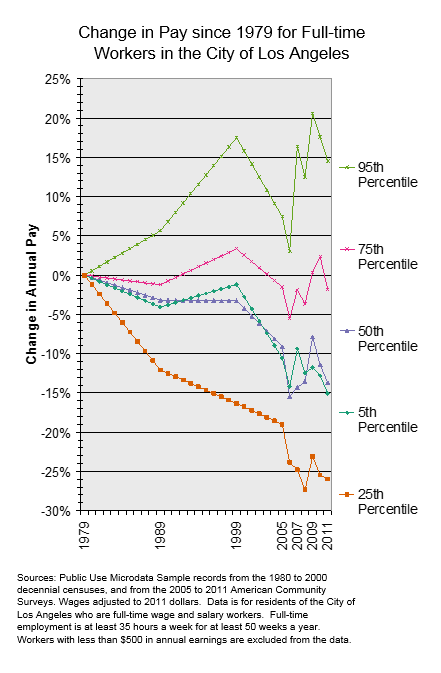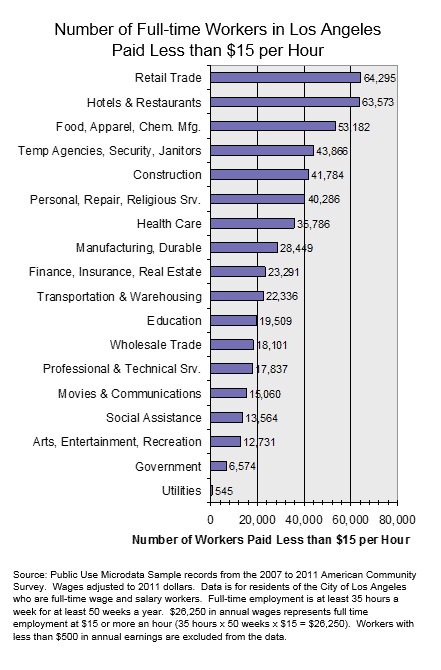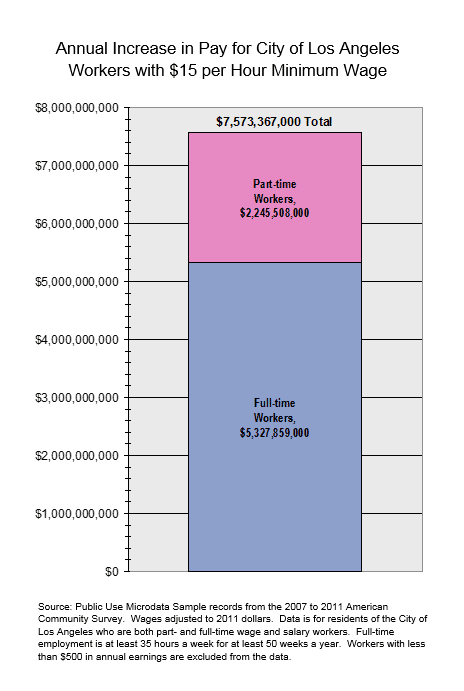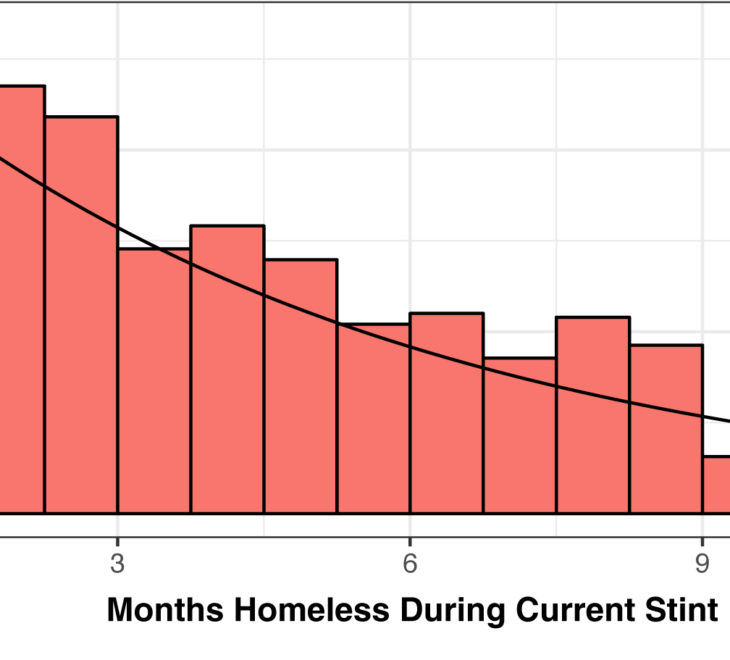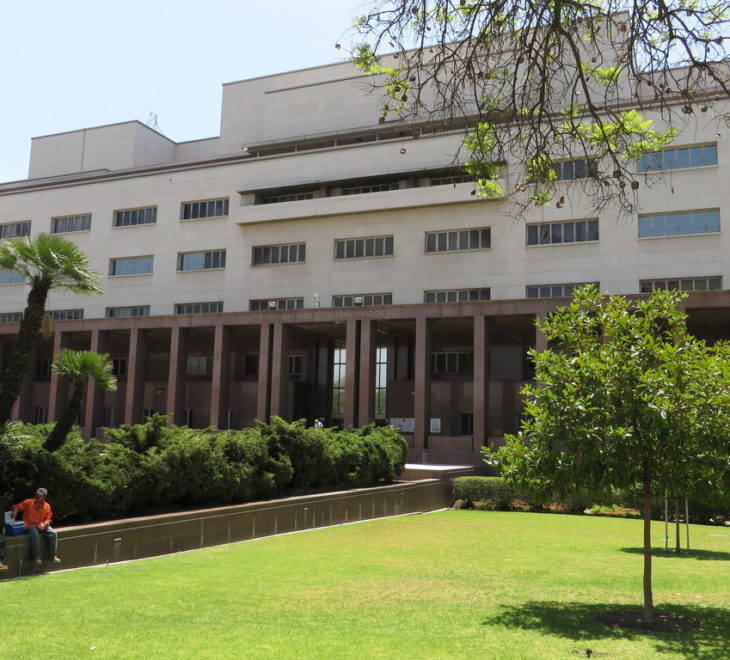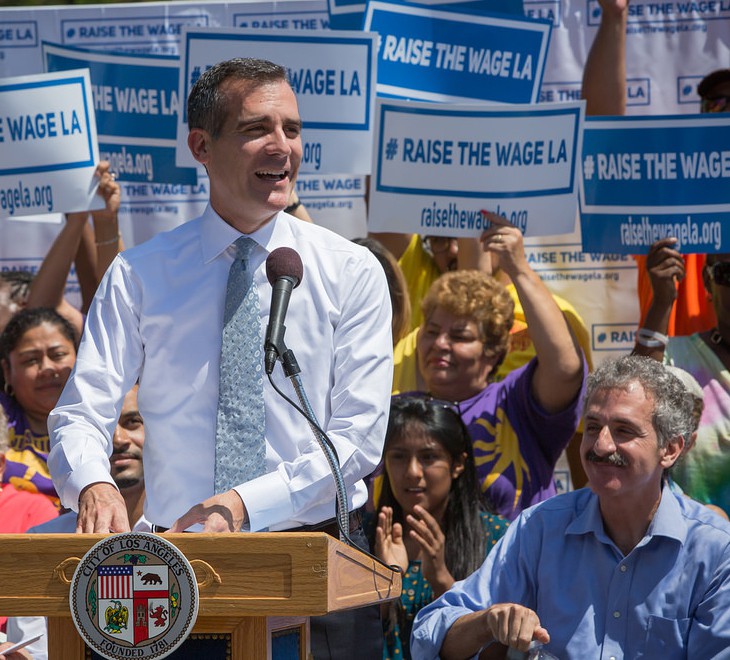Report Summary
America has lost ground on the intent declared by Congress when the Fair Labor Standards Act was enacted in 1938, that workers will receive wages sufficient to maintain “the minimum standard of living necessary for health, efficiency, and general well-being.” The federal minimum wage had the greatest value in 1968. Set at $1.60 an hour, it had a value of $10.51 in 2012 dollars. The current federal minimum wage of $7.25 is worth 31 percent less. This wage attrition is part of most people’s every day experience:
- Three-quarters of the full-time labor force residing in the City of Los Angeles earn less than comparable workers 30 years ago.
- Wage erosion was greatest for workers in the bottom half of the wage scale. From 1979 to 2011, annual pay dropped 14 percent for workers in the 50th percentile – the median or typical worker, and 26 percent for workers in the 25th percentile – the working poor.
- The average hourly wage for all workers residing in the City of Los Angeles in 2013 is estimated to be $27.85, yielding estimated annual pay of $58,244 for the average wage and salary worker.
- Forty-six percent of LA’s wage and salary workers are paid less than $15 an hour. This includes 41 percent of the 1,097,000 full-time employees and 54 percent of the 665,000 part-time employees who live in the City of Los Angeles.
Worker Impacts
The basic issue is whether workers should receive a share of the value they create through their work that is sufficiently large to support a basic standard of living. There is reasonable certainty that increasing the minimum wage will produce five outcomes:
- Low-wage workers will be paid more and their standard of living will improve.
- More money will stay in Los Angeles rather than being paid to stockholders who live elsewhere.
- The low-wage workers who receive the pay increase are likely to spend all of the money – households with incomes in the $30,000 to $39,999 range spend 106 percent of their pre-tax income. In contrast, households with incomes of $70,000 and higher, which include most stockholders, spend only 63 percent of their pre-tax income. More spending and economic stimulus occurs when money is in the pockets of lower-income workers than when it is in the pockets of higher income stockholders.
A living wage is conservatively defined as $15 an hour, based on the criteria set in the Fair Labor Standards Act of a wage sufficient to support the “minimum standard of living necessary for health, efficiency, and general well-being.” The Census Bureau defines full-time employment as 35 or more hours of work a week for 50 or more weeks a year. Thus, a full-time worker with a $15 per hour wage would be paid at least $26,250 a year.
Full-time employment in 2013 with a wage of $15 an hour produces an income that is roughly twice the poverty threshold, depending of family size. This is a minimal standard for “well-being” in a high-cost urban area like Los Angeles.
Los Angeles workers would receive $7.6 billion more a year in pay with a $15 minimum wage. The average full-time, low-wage worker, now working 2,150 hours a year and paid $9.55 an hour, would receive $11,729 more in annual pay. The average part-time, low-wage worker, now working 1,031 hours a year and paid $8.89 an hour, would receive $6,297 more in annual pay. The wage increase would benefit 811,000 workers, 454,000 of them full-time and 357,000 of them part-time.
Industry Impacts
The increased wages also benefit businesses in important ways:
- Businesses will benefit from having more money spent in the local economy.
- Businesses will benefit from having a higher-paid labor force that is more stably housed, reducing employee turnover and the associated costs for recruiting and training new employees. It costs an estimated 30 percent of a worker’s annual salary to replace that worker, so reducing the frequency of worker turnover results in significant cost savings for employers.
Most full-time, low-wage (less than $15 an hour) employees are working in retail and service industries that serve Los Angeles-area residents. Only 22 percent of low-wage workers are employed by industries like manufacturing, wholesale trade or information (movies, internet and publishing) that send products outside of the Los Angeles region. Thus, four out of five low-wage workers are doing things that serve other Los Angeles residents, without receiving enough pay to live decently.
Increasing the minimum wage to $15 an hour would increase the overall payroll for wage and salary employees by 10 percent. The current payroll is $77.8 billion. The increase would be an additional $7.6 billion.
Increasing the minimum wage to $15 would require reallocating 4 percent of overall industry revenue currently being used for other purposes.
Increases in payroll costs would be greater in low-wage, labor-intensive industries. Restaurants, hotels and personal service establishments would need to reallocate 14 percent of their revenue to raise employee wages. The next highest impacts would be in the nonprofit social assistance sector and administrative support services such as janitorial and security services and temp agencies, where increased labor costs would be equivalent to 13 percent of revenue. High-wage industries such as professional and technical services, information, finance, and utilities would have nominal impacts on the order of 1 percent of revenue.
Economic Stimulus
When workers’ households receive additional income, their increased spending stimulates growth in the local economy. Their increased purchases of groceries, clothes, meals out, health care, car repair services, and rental housing stimulates added purchases in the local supply chain. Jobs would be created in the same industries where workers would receive wage increases, including restaurants and retail stores. The increased buying power of workers would make these industries direct beneficiaries of the higher wages they would be paying.
The increased spending translates into added sales for local businesses and their suppliers, as well as added jobs at those businesses and their suppliers, and increased tax revenue for local, state and federal government.
Looking just at the stimulus effects, the added income that workers would receive from a $15 minimum wage would generate an estimated $9.2 billion in annual sales in Los Angeles County, and these increased sales would in turn create an estimated 64,700 new jobs in the county to meet the increased demand for goods and services.
Government and Social Service Benefits
Increased sales and employment would generate an estimated $1.3 billion in increased annual public revenue. Social safety net programs would receive $331 million of this revenue. One billion dollars would be general public revenue subject to legislative budget allocations by different levels of government.
An estimated 15 percent of this general public revenue would return to the City of Los Angeles, some through the city’s formula share of sales tax revenue, but the preponderance through state and federal budget allocations that return funds to the city. This share of public revenue would bring an estimated $152 million a year to the city.
Pro and Con Economic Debate
Increasing the minimum wage takes money out of one set of pockets and moves it to another set of pockets. There has been a long-running debate in economic literature about the effect of increasing the minimum wage – about whether it is a damper or a stimulus for employment.
The Fair Labor Standards Act of 1938 establishes a benchmark for increasing the minimum wage – it should not substantially reduce employment or increase inflation. The economic debate over increasing the minimum wage is now largely about whether modest increases in the minimum wage reduce the rate of job growth (rather than actually reducing employment), have little or no effect on employment, or stimulate job growth.
Over 650 economists, including five Nobel Prize winners and six past presidents of the American Economics Association, signed a statement stating that federal and state minimum wage increases “can significantly improve the lives of low-income workers and their families, without the adverse effects that critics have claimed.”
Why it is that transferring money from businesses to low-wage workers does not disrupt the economy? A review of economic studies since 2000 on the effects of the minimum wage and the ways in which businesses adjust to wage increases found that the most important channels of adjustment are reductions in labor turnover; improvements in organizational efficiency; and small price increases. Given the relatively small cost to employers of modest increases in the minimum wage, these adjustment mechanisms appear to be more than sufficient to avoid employment losses, even for employers with a large share of low-wage workers.
Many economists who have concluded that increasing the minimum wage does not harm the economy add the caveat that the increases should be incremental so as not to cause economic dislocations. For example, California’s recent action to increase the minimum wage to $10 an hour will be implemented in one-dollar annual increments.
Increases of the minimum wage should be enacted as part of a system for automatically adjusting the minimum to keep up with inflation. This will avoid the problem of deep wage erosion for low-wage workers and the need for large wage adjustments to return to parity.
Press Coverage
- Walton, Alice and Ben Bergman “Minimum wage hike could affect 4 in 10 LA workers, boost economy” KPCC News. September 2, 2014.
- Dreier, Peter, and Harold Meyerson (Op-Ed) “A local approach to bigger paychecks: If California and D.C. won’t raise the minimum wage, city and county leaders should go it alone” Los Angeles Times, March 30, 2014.
- Rothstein, Vivian. “Confronting L.A.’s Economy, Past & Present” Capital & Main blog. March 27, 2014.
- Rainey, James. “Bid to hike L.A. minimum wage gets pair of powerful backers” Los Angeles Times, March 1, 2014.
- Rainey, James. “Union ads seek to publicize L.A. workers making less than $15 an hour” Los Angeles Times. January 14, 2014.
- Hiltzik, Michael. “Will L.A. set the standard for a higher minimum wage?” Los Angeles Times. January 14, 2014.
- Covert, Bruce. “A $15 Minimum Wage In Los Angeles Could Create 64,700 Jobs” Politico and ThinkProgress. January 16, 2014. Reddit discussion.
- Rivas, Jorge. “L.A. to Consider the Highest Minimum Wage in the Country; Latinas Could Benefit Most” Fusion. January 21, 2014.
- Thoma, Mark. “What’s the best way to help the poor? Minimum Wage, EITC or Both?” MarketWatch. January 21, 2014.
Related Stories, Studies and Background Information
- Pilkington, Ed “How a powerful rightwing lobby is plotting to stop minimum wage hikes” The Guardian, February 20, 2015.
- Lopez, Steve “Finding balance in L.A.’s minimum wage discussion” Los Angeles Times, January 25, 2015.
- White, Martha C. White “Higher Minimum Wage Wouldn’t Hurt Fast Food, Report Says” NBC News: Business/Economy, January 22, 2015.
- Pollak, Joel “Under pressure, L.A. Times shifts coverage of minimum wage” Breitbart.com, October 27, 2014.
- Loungani, Prakash “Does Raising the Minimum Wage Hurt Employment? Evidence from China” IMFdirect, October 23, 2014.
- Smith, Dakota “Los Angeles City Council members call for new study of Mayor Eric Garcetti’s minimum wage proposal” Los Angeles Daily News, October 21, 2014.
- Leamer, Ed and Daniel Flaming (Op-Ed Dialogue) “Raising the minimum wage: Would it help or hurt L.A.?” Los Angeles Times, October 11, 2014.
- Kirkham, Chris and Tiffany Hsu “Living on the bare minimum: Who makes less than $13.25 in Los Angeles?” Los Angeles Times, October 11, 2014.
- Cavanaugh, Kerry (Opinion) “What’s the right minimum wage for Los Angeles?” Los Angeles Times, October 9, 2014.
- Morath, Eric “Mayor Garcetti’s Plan to Lift Minimum Wage to $13.25 an Hour Would Make L.A. Prime Test of How High Pay Floor Affects Economy” Wall Street Journal. October 2, 2014.
- Belman, Dale and Paul J. Wolfson “What Does the Minimum Wage Do?” W.E. Upjohn Institute for Employment Research. 471 pp. 2014.
- Hsu, Tiffany and Chris Kirkham “L.A. small-business owners weigh both sides of a wage hike” Los Angeles Times, September 22, 2014.
- (Editorial) “A higher minimum wage makes sense for L.A., but it’s no cure-all” Los Angeles Times, September 14, 2014.
- Alpert Reyes, Emily “Garcetti asking nearby cities to join L.A. in boosting minimum wages” Los Angeles Times, September 15, 2014.
- “Ballot Initiative Hiking Minimum Wage To $15 To Begin Collecting Signatures” CBS Los Angeles, September 10, 2014.
- Paige, Randy “Mayor Garcetti, Businessman Eli Broad Defend Wage Plan: ‘This Is The Way Forward’” CBS Los Angeles, September 2, 2014.
- Henn, Steve “A Mall With Two Minimum Wages” National Public Radio (NPR) News, Planet Money, August 28, 2014.
- Hsu, Tiffany “Loss of mid-wage jobs hampers state’s growth” Los Angeles Times, August 8, 2014.
- Hsu, Tiffany “Freelance workers a growing segment of California economy” Los Angeles Times, August 2, 2014.
- Walker, Chris “Could a City-Wide $15 Minimum Wage Be Coming to L.A.?” LA Weekly, July 14, 2014.
- Allegretto, Sylvia A. and David Cooper “Twenty-Three Years and Still Waiting for Change: Why It’s Time to Give Tipped Workers the Regular Minimum Wage” Economic Policy Institute. July 10, 2014.
- Jones, Carolyn “East Bay Mayors Looking to Raise Minimum Wage Together” San Francisco Chronicle. June 23, 2014.
- Schroeder, Robert “Capital Report: IMF urges U.S. to raise minimum wage” Wall Street Journal MarketWatch. June 16, 2014. Read the IMF’s review.
- Meyerson, Harold (Commentary) “Studies Show Raising Wages Creates Jobs” Morning Sentinel (Waterville, Maine), June 4, 2014. Article cites The Paychex-IHS Small Business Jobs Index.
- Gordon Blankinship, Donna “$15 Minimum Wage Permits Few Luxuries in U.S. Cities” Associated Press. June 2, 2014 (appearing in the Concord Monitor on Tuesday, June 3, 2014).
- Mason, Melanie and Patrick Mcgreevy. “State a Step Closer to Minimum Wage Hike, Paid Sick Leave” Los Angeles Times. May 30, 2014.
- Meyerson, Harold (Op-Ed) “The Boost That Comes From Raising the Minimum Wage” Washington Post, May 21, 2014.
- Meyerson, Harold (Op-Ed) “What to do about L.A.’s sky-high rents” Los Angeles Times, April 24, 2014.
- Thompson, Lynn “Studies look at what happened when cities raised minimum wage” Seattle Times, March 12, 2014.
- (Editorial) “Why help just L.A.’s hotel workers earn more?” Los Angeles Times, March 10, 2014.
- Winters, Michael Sean. “LA labor leaders invite Pope Francis to visit their city” National Catholic Reporter, March 5, 2014.
- Lopez, Steve. “Women’s workplace struggles could someday be her dissertation” Los Angeles Times, March 1, 2014.
- (Editorial) “Business and the minimum wage” New York Times, February 27, 2014.
- Morrison, Patt “Patt Morrison Asks: Ron Unz, a mo’ money man on the minimum wage” Los Angeles Times. February 26, 2014.
- Harris, Larry (Op-Ed) “Raise the minimum wage? No, subsidize wages instead” Los Angeles Times, February 21, 2014
- Gianattasio, Jeffrey. “Cities and Minimum Wages” Center for Economic and Policy Research. January 27, 2014.
- Bernstein, Jared and Sharon Parrott. “Proposal to Strengthen Minimum Wage Would Help Low-Wage Workers, With Little Impact on Employment” Center on Budget and Policy Priorities. January 7, 2014.
- Stoehr, John. “Inequality: Is Obama Serious About Economic Justice?” Boston Review. January 10, 2014.
- Kearney, Melissa S. and Benjamin H. Harris. “The “Ripple Effect” of a Minimum Wage Increase on American Workers” Brookings Institute: Hamilton Project. January 2014.
- Kestenbaum, David. 2014. “The Birth of the Minimum Wage in America” National Public Radio, Planet Money. January 17, 2014.
- (Editorial) “Raise the minimum wage” Los Angeles Times, September 13, 2013.
- Lifsher, Marc “California Legislature approves raising minimum wage to $10” Los Angeles Times. September 12, 2013.
- Schmitt, John “Why Does the Minimum Wage Have No Discernible Effect on Employment?” Center for Economic and Policy Research. February 2013.
- History of California Minimum Wage. California Department of Industrial Relations, Industrial Welfare Commission. Sacramento, CA.
- Minimum Wage. California Department of Industrial Relations, Industrial Welfare Commission. Sacramento, CA.
- Minimum Wage Overview. US Department of Labor, Wage and Hour Division (WHD). Washington DC.

